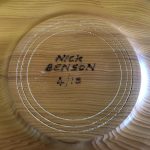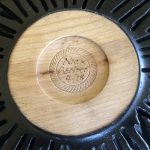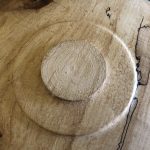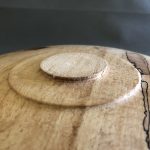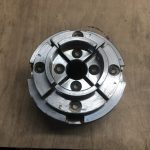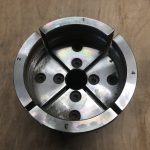Introduction – Getting a Grip!
This article is a consideration of how best to hold your bowl blank in your chuck. You will find different wood turners all have different views on this topic. Personally, I think there is a place for both techniques. The inner technique requires a slight recess in the base of your bowl blank, perhaps 3mm deep, of a diameter slightly more than your chucks jaws when nearly closed, with a dovetail edge to the rim of the recess. The outer method is the reverse, a spigot is formed perhaps protruding 3mm, also with a dovetail edge, and of a diameter to fit inside the jaws when nearly closed and forming a near perfect circle. Each method has advantages and disadvantages, part of your evolving skill is picking the best method for your turning plan.
The Jaws
So. let’s unpick the stages to this decision to help inform your choice. I have three sizes of these jaws often referred to as Type C. They have a slightly dovetailed cross section on both the inner and outer rims. The standard size is 50mm often supplied as standard jaws with a new chuck. I also have 35mm ones which I use for smaller boxes and on rare occasions, I have to reform a spigot on a piece where the 50mm dovetail has become malformed. The 100mm can be used for larger work, but I use them primarily for the initial rough turning of green wood vase/urn blanks. As the blank dries, the spigot can distort, perhaps becoming more oval, so the blank has to be re-chucked between centres so the distorted 100mm spigot can be remodeled as 50mm, so I can re-hold the piece in the standard jaws. Woodturning is often about planning a job ahead of time and allowing for “design opportunities” as wood turners euphemistically refer to things not going as originally planned!
The Chuck
There is a range of chucks on the market that comes with what is often referred to as Type C jaws as standard at the time of writing, including the Nova G3 or SupaNova, Robert Sorby Patriot and Record SC4. I have a Patriot and an SC4. There is very little to choose between them.
The chuck jaws are manufactured as a disc, then sliced into accurate quarters normally using a 2mm slitting saw. This means a perfect circle is formed by the jaws when there is a 2mm gap between the quadrants. The woodturners aim, when creating a spigot, is to make it as near to the jaws perfect circle dimension as possible, which in turn means as much of the jaw rim is in physical contact with the spigot as possible. This ensures the strongest grip on the spigot, supports the spigot and gives an even grip around the spigot. The reverse is true for a recess. When the jaws are expanded into the dovetailed recess they should also form a near perfect circle.
The Dovetail
The base of the bowl should firstly be trimmed to a flat even surface. Then, the dovetail should be carefully cut to the correct depth, often with a part-tool, then trimmed up to a dovetail section to match the dovetail angle, on your chuck jaws. Many people prefer to use a small skew chisel as a scraper for this finishing cut. It is important that the angle of the dovetail does match your jaws, again to make sure there is good even contact between the jaws and timber. You should also check that the root of the dovetail is clean and not full of dust, so the jaws sit correctly. The recess for an expansion grip should be cut similarly. Firstly, a groove is cut to allow the jaws to enter and sit snuggly against the base of the bowl. Turners often remove all the wood from the recess at this stage. Again, the correct dovetail is formed on the outer edge of the recess, allowing the jaws to expand snuggly into place.
The Grip
Following the steps previously described above should give you a strong dovetail for the jaws to grip. Most woodturners feel the compression effect of gripping the spigot is the strongest method, although if you experience a major catch, your work can either be ripped from the jaws or the spigot can become severed! The expansion method in a recess is strong while the bowl blank is unrefined, but as soon as you start forming the foot of a bowl, the ring of timber then formed has the potential to split with the wedge-like chisel pressure the jaws are applying. The turner just needs to be aware of the issues and adjust their cuts appropriately. One other factor to bear in mind is the wood density, which can affect how much the wood can be compressed under the mechanical pressure of the steel jaws. Soft timbers like Lime can be deformed very easily, whereas Oak less so. Consideration should also be given to timbers that split with the grain easily, like Ash. This timber is often used for shingles and similar purposes because it can be readily split, but this can work against us in an expansion chuck grip scenario. Do not let this put you off, just balance the factors in your planning after all Ash is a fabulous timber offering many possibilities in creative turning.
Finishing Up
Your piece is now finished, what’s next? If you used a recess, there’s nothing more to do. If you used a spigot, you now need to remove it. In-depth information can be found in my article Bowl Bottoms! For now, the stub can be removed by reverse chucking the bowl using a friction faceplate supported by the tailstock, cole jaws, Longworth or vacuum chuck. The stub is gently turned away with light cuts, leaving a slightly concave base. Your maker’s mark and any decoration should be applied before final finishing to match the rest of the piece.
Conclusion
So, Innie or Outie? The recess method is quicker and leaves a re-chucking point in the base of the bowl. Some decoration in the recess can re-enforce the idea this is a feature of the bowl, leaving a rim like on a ceramic plate. Apart from aesthetics, the major downside is the strength when the recess is part of the foot.
The stub method requires more work at the end of the job to remove it and means it is very difficult to re-chuck should that be needed. For purists, exhibitions, and competitions, no visible chucking point and a properly finished smooth bottom are essential features. In the end, it is your choice.


